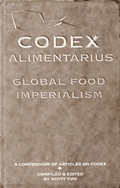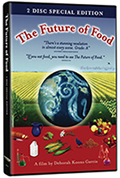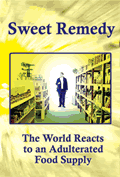MAKING TONS OF MONEY FORCING ILL-EFFECT DRUGS ON BILLIONS OF PEOPLE
by
Attorney Scott Tips, JD
July 21, 2015
NewsWithViews.com
 Scott
Tips arguing against rBGH, as shown on the Codex big screen
Scott
Tips arguing against rBGH, as shown on the Codex big screen
July 8, 2015
Most people would not think of Geneva, Switzerland as an uncomfortably hot city. But each and every time I’ve been here, it has been. The city was so hot this most recent trip that I actually saw two trees fighting over a dog.
Still, the reason for braving the heat here was a good and necessary one: The 38th session of the Codex Alimentarius Commission was being held this week of July 6-11, 2015 and one of the most important items to be debated on its agenda was the adoption of a Maximum Residue Limit (MRL) for recombinant bovine growth hormone (rBGH) or recombinant bovine somatotropin (rbST).
It might sound inconsequential, but it isn’t. As I have mentioned before, obtaining an MRL at Codex for rBGH is the marketing equivalent of a drug company being handed the “Keys to the City.” It is a license to sell the vet drug throughout the Codex member-state world, with World Trade Organization (WTO) sanction power behind it. Many Codex members and member states—such as the European Union, Norway, Switzerland, India, Russia, and China—have banned this genetically modified veterinary drug’s use on animals under a very sensible health policy that prohibits drug use on animals for anything other than therapeutic purposes. The vet drug rBGH, injected into cows, is not therapeutic; it is used to increase milk production. Yet, if an MRL is approved at Codex, then the Europeans and many others would be faced with a dilemma: Acquiesce to its introduction into their food supply or else pay heavy trade sanctions imposed upon them by the WTO.
Industry Science Supposedly Says rBGH is Safe
The Joint FAO/WHO Expert Committee on Food Additives (JECFA) has conducted three safety reviews of rBGH and its representative keeps insisting to the Codex delegates that these safety reviews have shown the veterinary drug to be safe, with no noticed increase in mastitis (udder infections) or antimicrobial residues from rBGH use. The JECFA representative at this meeting took the same position as she had expressed at the Codex Committee on Residues of Veterinary Drugs in Foods held in Costa Rica last April, that JECFA’s “systematic review of the literature published since the 50th JECFA [1998] did not find any significant difference in the incidence of mastitis … [nor] specific studies correlating the use of rbST with the development of antimicrobial resistance.”
Pro-rBGH delegates at the current meeting were not shy about repeatedly pointing out that this was JECFA’s third review of rBGH for safety. How could anyone, they hypnotically demanded time and again, possibly have an issue with three JECFA reviews that found no safety concerns for rBGH? And besides, they added, since this Codex standard has been on hold for fifteen years, we would be harming Codex’s credibility were we to turn our backs on JECFA science and refuse to adopt the MRLs for rBGH that JECFA assures us are safe.
Every Western Hemispheric country but Canada (which had to sit silently on its hands since Health Canada had declared rBGH unsafe) was in favor of adopting this MRL. Most African countries and many Asian countries declared the same, along with every two-bit Pacific or Caribbean island that the U.S. could fly in so as to add weight to the clamor for adoption.
So, What’s the Problem?
Only that the Codex delegates representing more than half of the World’s population do not believe that the JECFA risk assessment was either sound or scientific. Indeed, many thought the risk assessment was very political and industry-influenced. The NHF had also strongly argued at the previous meeting that JECFA had overlooked negative study results from the industry itself, and even the product warning labeling for Monsanto’s rBGH product (Posilac), which cautions users about a possible increase in mastitis in cows injected with Posilac.
Curiously enough, during its own first two reviews, JECFA had specifically excluded any consideration of mastitis issues, claiming that these safety problems were outside the scope of the JECFA review. So, contrary to pro-rBGH claims, there had not really been three JECFA reviews of all the issues.
My fellow NHF delegate, Robert Cohen – an expert on rBGH and its many dangers – argued that the goalposts for antibiotic use to treat mastitis had been moved so dramatically as to render them almost useless as a measure of antibiotic harm. It turns out, Cohen says, that FDA employee Dr. Margaret Miller (formerly with Monsanto) arbitrarily raised FDA’s allowable antimicrobial level 100 times from one part per hundred-million to one part per million. This has allowed more antibiotics to be passed along to humans in cow’s milk, with a resulting increase in antimicrobial resistance (i.e., pathogens resistant to antibiotic use by humans to kill those bad bugs).
In addition, Cohen pointed out that a herd of Holstein cows injected with the genetically engineered bovine growth hormone presented extremely shocking results upon autopsy, which the FDA and Monsanto did not make public. It was only upon publication in a dairy magazine that consumers learned that rBGH-injected cows lost an average of 100 pounds after six months, but that their hearts and spleens and other stressed organs had grown abnormally large.
 NHF
delegate Robert Cohen & NHF Delegation Head Scott Tips
NHF
delegate Robert Cohen & NHF Delegation Head Scott Tips
Dr. Michael Hansen of Consumers International (CI) was at this meeting and argued, among other things, that studies have shown that: (1) rBGH use significantly increases mastitis rates; and (2) the average length of treatment for a case of mastitis is almost six times longer in the rBGH-treated cows compared to untreated cows.
Because some dairy farmers deliberately use off-label and other antibiotics that are not tested for by the government and use them for longer periods of time, antibiotic use in cows is far greater than reported by the government or industry. Given that rBGH-injected cows need more antibiotics to cope with their greater health problems, such hidden use is not surprising. If the milk coming from these dairy farms exceeds even the lax antibiotic levels permitted by the FDA, then the dairy farmers face huge economic losses as their milk is rejected for sale. Unfortunately, though, the bottom-line is that rBGH-injected cows have more health issues, which in turn results in more antibiotic use, which in turn results in humans developing antimicrobial resistance (AMR, as Codex puts it) to harmful pathogens.
Yet, despite this and an enormous amount of other evidence out there, JECFA and its worshippers at Codex continue to insist that rBGH is safe. With AMR, JECFA has even twisted the lack of data on AMR into a conclusion that AMR is not an issue with rBGH use! As every true scientist knows, an absence of data means scientists wait to draw conclusions until they have the data.
Too, we suspect that JECFA’s expert body on AMR may not be as disinterested as they should be in making their risk assessments of rBGH. An NHF investigator found that one of the Codex Antimicrobial experts, Y. Tamara, was working for Mead Johnson's GMO division in 2004 where he obtained a U.S. patent for a GMO grain.
The truth is that alarm bells are ringing everywhere, and have been for decades, about the dangers of this non-medical drug use on animals; and, yet, our supposed scientific authorities sit there and act as if nothing is wrong at all. Others, conditioned to blindly accept “scientific” pronouncements no matter how badly based, shore up these rickety pronouncements with their unthinking support. If JECFA were truly doing its job, then it would be ruthless about tracking down each and every hint of evidence that rBGH poses a human and animal health problem. But, sadly enough, JECFA’s reviews were third rate.
The Codex Dog-and-Pony Show
It happens every time. It happened with ractopamine, GMO labeling, melamine, and now rBGH. The countries and trade groups that want to make money off of some drug or food product will present their “science” showing how incredibly safe it is and how we would all be idiots if we didn’t accept the product immediately. It is then up to us to show that they are wrong and that the science indeed shows health risks. If they are able to snag JECFA on their side, then they will also argue that Codex must not insult Codex and appear stupid for not following its own body’s scientific risk assessment. The arguments go back and forth until one side wins.
The problem, though, is that Codex-system inertia and bias is on the side of any proposed standard. “We need this standard,” the Burkina Faso delegate said about rBGH. “We will lose our credibility [look stupid] if we do not pass a standard,” Brazil chimed in. Many others agreed. Typically, the countries and industries pushing the standard only think in one direction: Push the standard forward to completion. As I argued at the meeting, they are like drivers who have taken a wrong turn and are now claiming that the only way out is forward, not a retracement of the route, otherwise the driver will “look stupid.” No, as we all know, the driver will look stupid if he or she continues forward on the wrong path, just as with this rBGH standard.
 Codex
venue in Geneva, Switzerland
Codex
venue in Geneva, Switzerland
Codex Steps Back From the Brink
With the rBGH standard having been held at Codex’s final Step 8 for fifteen years, the United States and its minions had pulled out all of the stops at this year’s meeting to give this standard a final push over the edge and get it adopted. In anticipation of forcing a rare vote on the standard, they had flown in every small and large country they could, with who-knows-what promises – a free vacation in Geneva, free mastitis for life, or maybe a simple promise not to wire-tap its leaders’ communications. We don’t really know, but we do know that, otherwise absent from Codex meetings, these “now-you-see-them, now-you-don’t” delegations mysteriously seem to appear on cue for any meetings where a vote might be taken. And they always support the U.S. position.
If adopted at the final Step 8 at this Commission meeting, then the rBGH standard would be a done deal, ready for use as a weapon by the United States, Mexico, Brazil, and others who chose to export rBGH-doped milk into other Codex countries that actually care about their citizens’ health. It was the European Union, India, Russia, China, Norway, Switzerland, Turkey, Uganda, Botswana, Georgia, Consumers International, and the NHF against the Western Hemispheric countries, plus most African countries, New Zealand, and the ICGMA (International Council of Grocery Manufacturers Associations). Cuba, Costa Rica, and Brazil were the most outspoken in favor of adopting the rBGH standard, while the European nations, India, NHF and CI were the most adamant against its adoption.
India, which has a reputation for making the timeliest interventions, opposed adoption, stating that its own recent study showed problems with rBGH use in cows. It also argued that with 36 standards already having been adopted by the Codex Alimentarius Commission at this session, Codex was hardly at risk of having its credibility questioned if it refused to adopt this one.
NHF’s first intervention against adoption was spoken by Robert Cohen, who proceeded to lambast the FDA for its position on rBGH. It was so strong that, after the day’s session and while waiting for me to complete a radio interview, he was confronted by three FDA personnel who expressed their anger and hostility towards him. And the next day, when I “flagged up” again for NHF to speak, the Chairwoman, Awilo Pernet, was extremely hesitant to call upon me to speak, only doing so after I had spoken privately with their legal counsel and as the very last delegation to speak.
 The
conference room in Geneva for the Codex meeting
The
conference room in Geneva for the Codex meeting
With the debate spread over two days and seemingly inexhaustible, the Australian delegate (who expressed support for rBGH) wisely suggested that in light of an unmentionable previous experience (the adoption of a standard for ractopamine) where a standard had been forced down the throats of a majority of the World’s population by a mere one-country vote majority (remember, Tonga’s vote carries the same weight as China’s), the rBGH standard should be “parked” at Step 8 until such time as consensus could be reached. What Australia was telling everyone without saying it is that Australia did not support taking this up for a vote, which would be devastating for Codex and its member states politically. Weighing the cost, Australia very astutely found it wanting. Perhaps Australia had already felt the domestic heat from its ractopamine position, or perhaps Australia was simply being politically savvy. Regardless, the Australian position set the tone and any fervor by the pro-rBGH camp to vote on this standard evaporated, except for a few diehards such as Tonga.
The Chairwoman proposed a face-saving compromise that the MRLs for rBGH continue to be held at Step 8 and revisited at each annual meeting until consensus could be reached. Because it was a slap in the face to JECFA for this Commission not to adopt a standard that JECFA had found safe, the Chairwoman couched her compromise with a soothing opening sentence that “The Commission recognized the validity of JECFA’s risk assessments as the sound scientific basis for its deliberations on rbSTs.” This sentence was not true, though, as many delegations had challenged JECFA’s risk assessment as incomplete; and when finally given the chance to speak on this compromise, I was the only one to state this fact.
In the end, however, the Chairwoman had her way; and the rBGH standard was “parked” at Step 8, to be battled over in a future meeting. The World had won a reprieve.
Sanitized Codex Reports
Codex brags about its transparency. But its Commission and Committee reports say otherwise. Try to find out which delegation took a particular position on an issue. Good luck, because 95% of the time you won’t. The names have been omitted. NHF has protested this non-transparent practice across time and in many meetings, as the World should know what positions delegations have taken. Unfortunately, our protests have fallen on deaf ears.
The Final Reports are deficient in other ways as well: They are scrubbed clean, sanitized. One egregious example occurred on Saturday, July 11th, during the reading and correction of the Report of this meeting, when I asked for the floor so that NHF’s last comment about not agreeing with the validity of JECFA’s risk assessment could be inserted into the Report. I pushed the microphone button so that the Chairwoman Awilo Pernet would see NHF on her screen, along with those other delegations asking for the floor. I propped our name sign up so it was also visible. The Chairwoman called and kept calling on everyone but NHF. At strategic moments, I cancelled my computer-system request for the floor and pushed the request button again so that it would flash on her screen, again. I was still ignored. I even grabbed our NHF name placard off of its stand and waved it at arm’s length wildly above my head. Nothing. Thirty minutes in all had passed and the Chairwoman had still refused to recognize me at all.
The Chairwoman clearly feared that I would want to insert something negative about JECFA into the Report, but her refusal to recognize me to speak was absolutely inexcusable conduct on her part. And it is being protested and publicized far and wide as an example of misconduct. Even others came up to me afterwards and expressed their surprise at how we had been handled.
The bottom-line on Codex Reports is that they cannot always be trusted as a complete record of what transpired at the meetings. Future historians, as yet unborn, will have to mine articles such as this one to determine the substance of what really happened at these food-standard meetings.
rBGH Science is the Tartan Bag
In a hugely funny skit done by the British comedians Bill Bailey and Simon Pegg, the skit opens with Bill Bailey sitting on a stool at his baggage-claim counter at some indeterminate airport. The phone rings, and rings. Bailey lazily picks up the phone and answers in his most disinterested tone, “Lost luggage.” “Have you seen my tartan bag with green tags?” the voice at the other end desperately asks. Without moving off his stool, Bailey slowly looks to his right and down and then turns and does the same to his left. “No,” he eventually answers, “we haven’t found it.” And he hangs up.
The scene changes to Simon Pegg, the fresh blood, now sitting on the same stool at the same counter, with his hand eagerly hovering over the phone, just waiting for it to ring. It barely rings before Pegg scoops it up and gets the same query as before, “Have you seen my tartan bag with green tags?” “Green tartan bag!” he barks back, “I’m there!” He leaps off his stool and is already running by the time his feet are barely on the ground. Pegg runs through the airport, hounding passengers, commandeering the public announcement, riding the baggage carousel and throwing off bags, until eventually hours later he finds the tartan bag. He triumphantly takes it back and plunks it down on the counter in front of Bailey, who, now sitting at the lost-luggage counter, then phones the owner and claims credit for having found it.
|
|
In this modern-day parable, we have JECFA as Bill Bailey and NHF, India, the European Union, and CI as Simon Pegg. We run around and find all of the evidence for the considerable health risks of rBGH while JECFA barely glances around and sees nothing. Yet, mark my words, when JECFA does eventually come around and sees the light, everyone will be acclaiming and applauding JECFA for its thorough search. And the funny thing is that we will be among those applauding, because, after all, one more health risk will have been removed from our food and they can get the credit just so long as we get the health.
� 2015 - Scott Tips - All Rights Reserved














 Share
This Article
Share
This Article





